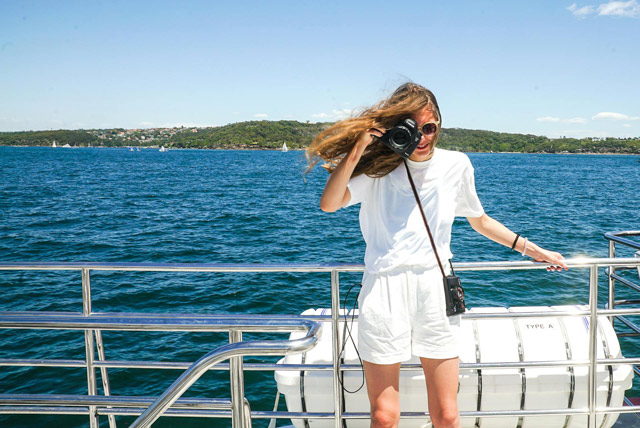Whale watching in Montauk offers incredible opportunities to capture breathtaking photos of these magnificent creatures. But let’s be honest—trying to take great photos of whales on a moving boat, while trying to focus on wild animals that might appear suddenly, isn’t easy! With the right preparation and a little practice, you can return home with stunning memories.
Prepare Your Equipment
Before heading out on your whale-watching adventure, it’s essential to make sure your camera gear is ready to handle the unique challenges of photographing on the water. With the right tools and a little preparation, you’ll be ready to capture those magical moments.
A DSLR or mirrorless camera with a zoom lens (200mm or more) is ideal for whale photography. These cameras allow you to zoom in on distant whales while maintaining sharp, high-quality images. If you’re using a smartphone, don’t worry—modern models with telephoto features can also deliver stunning results. Many smartphones now offer high-resolution zoom capabilities and even burst modes for capturing action shots.
Here’s a checklist to help you prepare:
- Camera gear:
- Bring a camera with a fast shutter speed option to capture moving whales.
- Use a zoom lens (200-400mm range) for close-up details of breaches, tails, and dorsal fins.
- Smartphone tips:
- Ensure your phone is fully charged.
- Use a clip-on telephoto lens for added zoom if your phone doesn’t have one built in.
- Explore your phone’s camera settings to enable burst or manual mode for better control.
- Essentials to pack:
- Extra batteries: Cold ocean air can drain batteries faster than you expect, so always pack spares.
- Memory cards: Bring a few high-capacity cards to avoid running out of storage during the trip.
- A microfiber cloth: Saltwater spray and mist can fog up your lens, so keep this handy for quick cleaning.
- Stability aids:
- Consider using a monopod for extra stability—tripods can be cumbersome on a moving boat.
- A camera strap with padding can keep your gear secure and comfortable to carry during the tour.
- Protective gear:
- Use a weather-resistant bag to protect your camera from splashes and spray.
- Bring a rain cover or plastic bag for your camera in case of unexpected weather.
Taking time to prepare your gear will help you stay focused on enjoying the experience rather than worrying about equipment malfunctions. Remember, being ready increases your chances of capturing incredible shots that you’ll cherish forever!
Finding the Right Settings to Take Great Photos of Whales
Capturing stunning photos of whales requires adjusting your camera settings to handle the fast movements and unpredictable nature of these majestic creatures. With a little practice, you can fine-tune your settings to freeze the action and make your shots crisp and clear.
For DSLR or mirrorless cameras:
- Shutter speed: A fast shutter speed of 1/1000 or faster is essential to freeze the motion of breaching whales, tail slaps, or fins cutting through the water. If the lighting is low, adjust other settings to maintain this speed.
- ISO: Start with an ISO of 400 in bright conditions. In overcast or low-light settings, increase the ISO incrementally to avoid blurry photos while minimizing noise.
- Aperture: Use a moderately narrow aperture, like f/8 or f/11, to keep the whale in focus while maintaining depth of field for surrounding water.
- Autofocus: Switch to continuous autofocus mode (AF-C or AI Servo) to track the whales as they move across your frame.
- Burst mode: Activate burst or continuous shooting mode to capture multiple frames quickly, increasing your chances of getting the perfect shot during action moments.
For smartphones:
- Pro or Manual mode: Many smartphones offer advanced camera controls. Use this mode to manually adjust shutter speed and ISO for more precise control.
- Focus tracking: If your phone supports it, enable focus tracking to keep the whale sharp as it moves.
- HDR mode: In bright conditions, use HDR mode to balance the exposure and bring out details in both the water and the whale.
- Exposure adjustment: Tap on the screen where the whale is to lock focus and adjust exposure. Slide up or down to brighten or darken the image.
Things to Keep in Mind
- Test shots: Take a few test photos of the water before the action begins to ensure your settings are dialed in for the current lighting.
- Check your histogram: Use your camera’s histogram to ensure your images aren’t overexposed (too bright) or underexposed (too dark).
- Use presets: Many cameras have an “Action” or “Sports” preset, which automatically optimizes settings for fast-moving subjects.
With these settings in place, you’ll be ready to photograph incredible whale moments like spouts, breaches, and playful behaviors. Remember, practice makes perfect, so don’t be afraid to experiment and learn as you go!
Fun Fact!
Did you know humpback whales can leap as high as 40 feet out of the water during a breach? Capturing this moment with a fast shutter speed will make it look even more dramatic.
Timing is Everything
Whales don’t always follow a schedule, but patience pays off. Look for signs of activity like spouts, tails, or dorsal fins to anticipate their movements. Often, whales will dive and resurface in predictable patterns.
Morning tours often have softer lighting, which is great for photos, while afternoon tours can showcase dramatic lighting effects as the sun lowers.
Pro Tip!
If you’re taking photos in the early morning, avoid shooting directly into the sun to reduce glare and achieve clearer shots.
Positioning on the Boat
Where you stand on the boat can make all the difference. Head to the bow (front) or the upper deck for the best vantage points. If you’re too far back, your shots might include other passengers instead of whales.
Keep your camera steady by using your body to brace against the railing or a solid surface. If you have a monopod, bring it—it’s lighter and easier to manage than a tripod on a moving boat.
Fun Fact!
Fun Fact #2: Whales often swim in pods, so if you see one, chances are more are nearby!
Compose Like a Pro
Composition is key to making your whale photos stand out. Use the rule of thirds: imagine your frame divided into nine equal sections and position the whale along one of these lines for a more dynamic shot.
Include some of the ocean or sky in your frame to show the scale of the whale. If you’re lucky enough to capture a breach, zoom out slightly to ensure you don’t cut off the splash.
Pro Tip!
Pro Tip #2: Experiment with burst mode on your camera to take multiple shots quickly. This increases your chances of capturing the perfect moment.
Make the Most of Each Encounter
Don’t get so focused on your camera that you forget to enjoy the experience. Take a few photos, then put your camera down and soak in the sight of these majestic creatures. Sometimes, the best memories aren’t the ones on film.
Fun Fact!
Blue whales—the largest animals on Earth—can weigh as much as 15 school buses. While they’re not commonly seen near Montauk, you never know what surprises the ocean might hold!
Final Thoughts
Whale photography is as much about patience and preparation as it is about technical skills. Whether you’re using a high-end camera or your smartphone, the goal is to capture the magic of whales in their natural habitat. With these tips and a little luck, you’ll have photos you’ll cherish forever—and maybe even frame on your wall.


